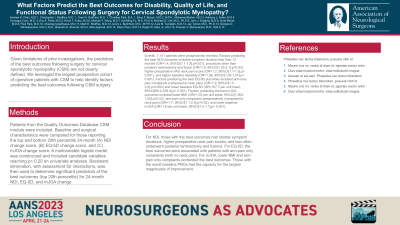What Factors Predict the Best Outcomes for Disability, Quality of Life, and Functional Status Following Surgery for Cervical Spondylotic Myelopathy?
Friday, April 21, 2023


Andrew K. Chan, MD
Assistant Professor of Neurological Surgery (in Orthopaedic Surgery)
Columbia University Medical Center
New York, New York, United States
ePoster Presenter(s)
Introduction: Given limitations of prior investigations, the predictors of the best outcomes following surgery for cervical spondylotic myelopathy (CSM) are not clearly defined. We leveraged the largest prospective cohort of operative patients with CSM to help identify factors predicting the best outcomes following CSM surgery.
Methods: Patients from the Quality Outcomes Database CSM module were included. Baseline and surgical characteristics were compared for those reporting the top and bottom 20th percentile 24-month (A) NDI change score, (B) EQ-5D change score, and (C) mJOA change score. A multivariable logistic model was constructed and included candidate variables reaching p< 0.20 on univariate analyses. Backward elimination, with assessment for interactions, was then used to determine significant predictors of the best outcomes (top 20th percentile) for 24-month NDI, EQ-5D, and mJOA change.
Results: Overall, 1,141 patients were prospectively enrolled. Factors predicting the best NDI outcomes included symptom duration less than 12 months (OR=1.4, 95%CI[1.1-1.9],p=0.01), procedure other than posterior laminectomy and fusion (OR=1.5, 95%CI[1.03-2.1],p=0.03), higher preoperative VAS neck pain score (OR=1.2, 95%CI[1.1-1.3],p < 0.001), and higher baseline disability (OR=1.06, 95%CI[1.05-1.07],p < 0.001). Factors predicting the best EQ-5D outcomes included arm-only pain complaints (compared to neck pain) (OR=1.9, 95%CI[1.3-2.9],p=0.002) and lower baseline EQ-5D (OR=167.7 per unit lower, 95%CI[85.0-339.4],p < 0.001). Factors predicting the best mJOA outcomes included lower BMI (OR=1.03 per unit lower, 95%CI[1.004-1.05],p=0.02), arm-pain only complaints preoperatively (compared to neck pain) (OR=1.7, 95%CI[1.1-2.5],p=0.02), and lower baseline mJOA (OR=1.6 per unit lower, 95%CI[1.5-1.7],p < 0.001).
Conclusion : For NDI, those with the best outcomes had shorter symptom durations, higher preoperative neck pain scores, and less often underwent posterior laminectomy and fusions. For EQ-5D, the best outcomes were associated with patients with arm-pain only complaints (with no neck pain). For mJOA, lower BMI and arm-pain only complaints portended the best outcomes. Those with the worst baseline PROs had the capacity for the largest magnitudes of improvement.
Methods: Patients from the Quality Outcomes Database CSM module were included. Baseline and surgical characteristics were compared for those reporting the top and bottom 20th percentile 24-month (A) NDI change score, (B) EQ-5D change score, and (C) mJOA change score. A multivariable logistic model was constructed and included candidate variables reaching p< 0.20 on univariate analyses. Backward elimination, with assessment for interactions, was then used to determine significant predictors of the best outcomes (top 20th percentile) for 24-month NDI, EQ-5D, and mJOA change.
Results: Overall, 1,141 patients were prospectively enrolled. Factors predicting the best NDI outcomes included symptom duration less than 12 months (OR=1.4, 95%CI[1.1-1.9],p=0.01), procedure other than posterior laminectomy and fusion (OR=1.5, 95%CI[1.03-2.1],p=0.03), higher preoperative VAS neck pain score (OR=1.2, 95%CI[1.1-1.3],p < 0.001), and higher baseline disability (OR=1.06, 95%CI[1.05-1.07],p < 0.001). Factors predicting the best EQ-5D outcomes included arm-only pain complaints (compared to neck pain) (OR=1.9, 95%CI[1.3-2.9],p=0.002) and lower baseline EQ-5D (OR=167.7 per unit lower, 95%CI[85.0-339.4],p < 0.001). Factors predicting the best mJOA outcomes included lower BMI (OR=1.03 per unit lower, 95%CI[1.004-1.05],p=0.02), arm-pain only complaints preoperatively (compared to neck pain) (OR=1.7, 95%CI[1.1-2.5],p=0.02), and lower baseline mJOA (OR=1.6 per unit lower, 95%CI[1.5-1.7],p < 0.001).
Conclusion : For NDI, those with the best outcomes had shorter symptom durations, higher preoperative neck pain scores, and less often underwent posterior laminectomy and fusions. For EQ-5D, the best outcomes were associated with patients with arm-pain only complaints (with no neck pain). For mJOA, lower BMI and arm-pain only complaints portended the best outcomes. Those with the worst baseline PROs had the capacity for the largest magnitudes of improvement.
